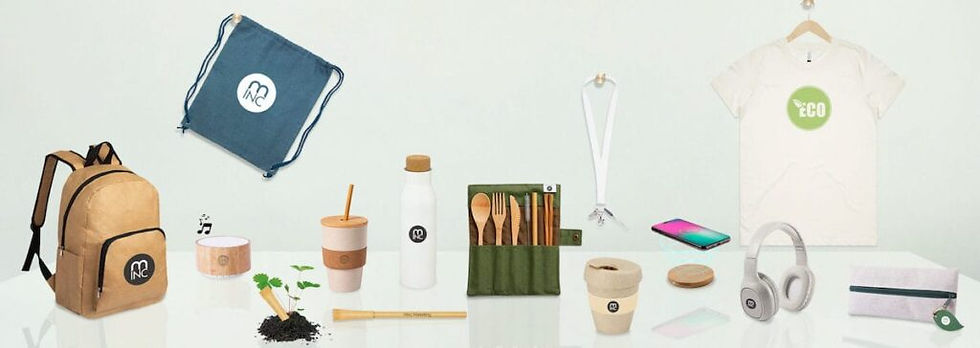Trade Show Swag - Avoid Arts & Crafts
- Thorne, Heidi
- Apr 23, 2024
- 3 min read
Updated: Jan 13

I am privileged to work with exceptionally creative clients and graphic designers who consistently produce outstanding ideas for promotional products. These collaborations continually push me to enhance my sourcing and solution-finding abilities. However, at times, their creativity can lead to concepts that are inefficient and impact profitability.
Occasionally, a team devises a giveaway concept that seamlessly aligns with a particular theme or the company's image. Upon presenting this concept to their supervisors or clients, they receive approval. Subsequently, they reach out to me as a promotional products distributor. However, the envisioned products frequently do not exist, leading to a challenging sourcing process.
At this stage, it is frequently necessary for me to perform a comprehensive database search to find comparable examples. However, the results rarely align perfectly with their artistic visions, necessitating a continued search. When these efforts prove insufficient, they are compelled to return to their companies or clients with entirely different proposals. This situation leads to wasted time and the potential for dissatisfaction among clients and supervisors. I regret being unable to bring someone's vision to fruition.
Let us look at a few examples to illustrate…
Over the years, I have received numerous requests from various individuals for custom figurines and models. This is an intriguing concept with the potential for significant impact. Are custom figures and models feasible? Certainly. However, unless you are a large corporation, the costs associated with design and mold fees render this idea impractical. Typically, such requests come from organizations seeking 50 to 500 items for their top clients and prospects. To make this type of product viable, one generally needs to consider quantities ranging from 10,000 to 100,000 or more. Furthermore, if the item could be classified as a toy, it must undergo safety inspections (particularly for lead and choking hazards), which can incur costs in the hundreds. Additionally, consider the time required for custom manufacturing, often conducted overseas, which can take several months.

When custom figures reach an impasse, the client or designer might choose to acquire a similar retail item and transform it into a promotional product. This process entails creating custom handmade labels, applying paint, attaching strings and bows, using glue, and wrapping in cellophane, effectively turning it into an arts and crafts project. Moreover, there is frequently a need to quickly obtain the necessary quantity from retail sources, resulting in a search across local stores.
If you're interested in seeing this in action, I recommend exploring successful self-promotion campaigns featured in graphic design magazines. These are notable arts and crafts showcases, which I have personally observed. It's important to consider the substantial time and financial resources invested in these projects, which might have been more effectively allocated towards networking or other revenue-generating activities. A further concern is that if designers employ such promotions for their own purposes, they may be suggesting similarly time and resource-intensive strategies to their clients.
Occasionally, the challenge lies not with the product itself but with its decorative elements. T-shirts frequently exemplify this issue. Individuals may envision a design that wraps around the neckline, extends along the shoulder, continues down the sleeve, and transitions seamlessly from the front to the back. Although this concept is appealing, executing such complex decoration often requires specialized handling and may not be achievable with standard decorating equipment. Furthermore, certain designs would need to be applied prior to the garment's construction, making this approach feasible only for substantial order quantities.
How can you avoid the common mistake of selecting arts and crafts items when purchasing promotional products?
Engage Your Promotional Products Distributor Early On. Your promotional products distributor can serve as a valuable partner. Collaborate with a distributor who prioritizes marketing. Discuss your ideas with them prior to presenting them to your team, superior, or client. This strategy will help avoid disappointment and facilitate a more efficient path to a viable solution.
Understand the Limitations of Imprinting. Your distributor can provide the imprinting specifications, including available areas and locations, for the promotional items you are considering. They can offer guidance and information on the available imprinting methods, assisting you in selecting the most appropriate option for both the project and the product.
Recognize that Time Equates to Money. Each minute devoted to crafting a distinctive and impactful promotion should be accounted for or billed accordingly. Clients and employers are compensating you for your expertise in marketing or design, rather than for completing tasks on a piecework basis. Furthermore, if the creation process is outsourced, the cost of the promotion can increase substantially. Consequently, whether utilizing your own time or that of others, it's crucial to meticulously assess labor costs for these projects.





Comments